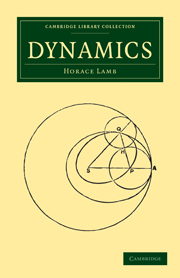Book contents
- Frontmatter
- PREFACE
- Contents
- CHAPTER I KINEMATICS OF RECTILINEAR MOTION
- CHAPTER II DYNAMICS OF RECTILINEAR MOTION
- CHAPTER III TWO-DIMENSIONAL KINEMATICS
- CHAPTER IV DYNAMICS OF A PARTICLE IN TWO DIMENSIONS. CARTESIAN COORDINATES
- CHAPTER V TANGENTIAL AND NORMAL ACCELERATIONS. CONSTRAINED MOTION
- CHAPTER VI MOTION OF A PAIR OF PARTICLES
- CHAPTER VII DYNAMICS OF A SYSTEM OF PARTICLES
- CHAPTER VIII DYNAMICS OF RIGID BODIES. ROTATION ABOUT A FIXED AXIS
- CHAPTER IX DYNAMICS OF RIGID BODIES (CONTINUED). MOTION IN TWO DIMENSIONS
- CHAPTER X LAW OF GRAVITATION
- CHAPTER XI CENTRAL FORCES
- CHAPTER XII DISSIPATIVE FORCES
- CHAPTER XIII SYSTEMS OF TWO DEGRESS OF FREEDOM
- APPENDIX. NOTE ON DYNAMICAL PRINCIPLES
- INDEX
CHAPTER XIII - SYSTEMS OF TWO DEGRESS OF FREEDOM
Published online by Cambridge University Press: 07 September 2010
- Frontmatter
- PREFACE
- Contents
- CHAPTER I KINEMATICS OF RECTILINEAR MOTION
- CHAPTER II DYNAMICS OF RECTILINEAR MOTION
- CHAPTER III TWO-DIMENSIONAL KINEMATICS
- CHAPTER IV DYNAMICS OF A PARTICLE IN TWO DIMENSIONS. CARTESIAN COORDINATES
- CHAPTER V TANGENTIAL AND NORMAL ACCELERATIONS. CONSTRAINED MOTION
- CHAPTER VI MOTION OF A PAIR OF PARTICLES
- CHAPTER VII DYNAMICS OF A SYSTEM OF PARTICLES
- CHAPTER VIII DYNAMICS OF RIGID BODIES. ROTATION ABOUT A FIXED AXIS
- CHAPTER IX DYNAMICS OF RIGID BODIES (CONTINUED). MOTION IN TWO DIMENSIONS
- CHAPTER X LAW OF GRAVITATION
- CHAPTER XI CENTRAL FORCES
- CHAPTER XII DISSIPATIVE FORCES
- CHAPTER XIII SYSTEMS OF TWO DEGRESS OF FREEDOM
- APPENDIX. NOTE ON DYNAMICAL PRINCIPLES
- INDEX
Summary
Motion of a Particle on a Smooth Surface.
A mechanical system is said to have n ‘degrees of freedom’ when n independent variables are necessary and sufficient to specify the positions of its various parts. These variables are called, in a generalized sense, the ‘coordinates’ of the system. Thus the position of a particle moveable on a spherical surface may be specified by its latitude and longitude; the configuration of the double pendulum in Fig. 64 (Art. 68) is specified by the angles θ φ; the position of a rigid body moveable in two dimensions may be defined as in Art. 63 by the two coordinates of its mass-centre and the angle through which it has been turned from some standard position; and so on.
The theory of a conservative system having one degree of freedom has been treated in a general manner in Art. 65. Since there is only one coordinate, the equation of energy, together with the initial conditions, completely determines the motion.
When we proceed to systems of greater freedom, the equation of energy is no longer sufficient, and a further appeal to dynamical principles becomes necessary. In the case of systems having two degrees of freedom, especially when the motion is in two dimensions, the principle of angular momentum can sometimes be made to furnish the additional information required, in a form free from unknown reactions. We have had an instance of this procedure in the theory of Central Forces (Arts. 76, 84).
- Type
- Chapter
- Information
- Dynamics , pp. 301 - 344Publisher: Cambridge University PressPrint publication year: 2009First published in: 1923

